#Lichenology
Note
How do reindeer survive on lichen? From the sound of it, lichens don’t grow fast enough to replenish being eaten, and reindeer are BIG, so presumably they need to eat a lot.
It's just a matter of numbers and time. Reindeer and caribou will greatly reduce lichen populations in specific areas, but if allowed to range naturally, they will move on to a new area and the populations can go through a recovery period over a number of years, and the cycle continues. Caribou and reindeer have huge migratory ranges, and this is one of the reasons. This is less of a problem in northern populations who have larger tracts of tundra to range around, and a greater problem for southern, woodland populations whose range has been restricted due to human development and habitat degradation. This can happen with any grazing/browsing system, not just lichen, but the recovery time is much much longer. Also keep in mind the concept of carrying capacity--if the system gets overgrazed, many more individuals will die of starvation and the grazer population will go down and the forage will increase. It's harsh, but that's the delicate balance of nature for ya.
209 notes
·
View notes
Text


Lichen doodles from my sketchbook ✏️💚
#lichen#lichens#lichenology#mycology#fungi#algae#botany#ink sketch#ink drawing#doodles#doodling#doodle#sketchbook#sketches#art journal
1K notes
·
View notes
Text

Tubifera ferruginosa fruiting around a Cladonia sp. lichen by John MacKay
#tubifera ferruginosa#tubifera#myxomycota#slime mold#slime mould#lichen#cladonia#lichenology#mycology#myxomycology#nature photography#forest floor#forest photography#macro photography#clusters#trypophobia
712 notes
·
View notes
Text
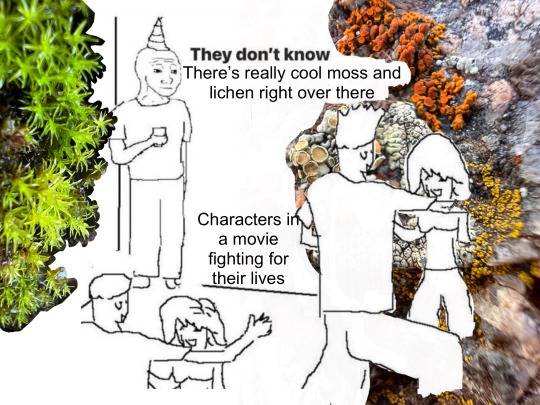
I made my family pause Jurassic park bc there were cool lichens
#moss#mosscore#botany#bryology#lichenology#bryophyta#bryophytes#lichen#lichen memes#botany meme#botany shitposts#biology meme#botany memes#moss memes
942 notes
·
View notes
Text







Bushy beard lichen 》 Usnea strigosa
Some lovely beard lichens I found at our campsite.
Caddo Lake State Park, Texas, 3 Aug. 2024
#amatuer mycology#mushrooms#mushroom hunting#mycology#fungi#mushrooms of texas#texas mushrooms#fungi of texas#wild fungi#fungarium#foraging texas#lichen#lichens#lichens of texas#beard lichen#bushy beard lichen#usnea#Usnea strigosa#special interest#species identification#lichen identification#lichenology#caddo lake state park#canon rebel#goblincore#naturecore#crowcore#nature photography
69 notes
·
View notes
Text

Devil's Matchstick
#artists on tumblr#original photographers#original photography#hiking#pacific northwest#nature#washington#pnw#nikon#orofeaiel#lichens#lichenology#devil's matchstick#macro photography#naturecore#goblincore#olympic national park#green
80 notes
·
View notes
Photo


Oakmoss lichen Evernia prunastri & Physcia leptalea
#cottagecore#dirtcore#goblincore#nature#nature photography#biology#ecology#wildlife#wildlife photography#macro photography#lichen#lichens#lichenology
833 notes
·
View notes
Text
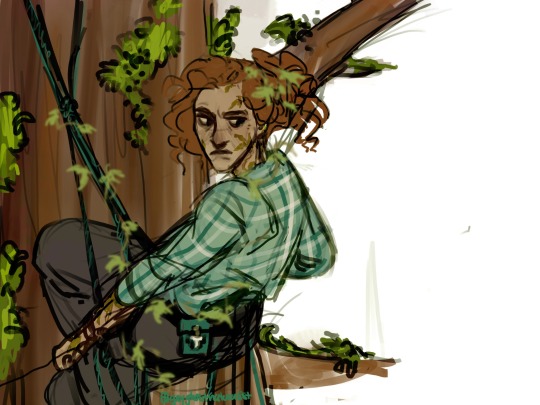

Quick sketch of Pamela in a tree and Letharia columbiana on a ponderosa pine 😤🙌 It’d be cool to get to climb a tree like this for lichens, the ones I study are on small boulders. Letharia are this bright yellow-green color because of vulpinic acid, which we think the lichen makes to use as a sunblock. See if you can spot them in your area! You might see them spot you back, their common name is “brown-eye wolf lichen”. The “eyes” are the apothecia, they spread the spores of the fungi. You can think of apothecia basically as mushroom cap turned upside down like a bowl.
#poison ivy but she’s an actual botanist#pamela isley#dr pamela isley#botany#lichenology#Letharia#wolf lichens#lichens#poison ivy fanart#poison ivy art#poison ivy design#artists on tumblr
310 notes
·
View notes
Text

tfw every specimen you thought was Caloplaca saxicola is just Rusavskia elegans.
(hi I'm alive and I did get into grad school which is why I've been neglecting this blog and will probably continue to do so. but please enjoy this image it took forever to make lmao)
#lichen#lichens#lichenology#old memes#science#biology#just lichenology things#Rusavskia elegans#Caloplaca saxicola
14 notes
·
View notes
Text
When I lead guided nature tours, I often have people asking me if the lichens we see are harming the trees they grow on. So I decided to make a little video about it!
(Follow my shiny new TikTok at https://www.tiktok.com/@rebeccathenaturalist/)
61 notes
·
View notes
Text










Psora vallesiaca
Fishscale lichen
I have been MIA lately due to travel and then a resulting COVID infection that has knocked me on my ass for the past week. Forgive for my absence, and as recompence, accept this squamulose, terricolous lichen native to northern Africa, Europe, Greenland, and northern North America. Isn't he adorable? P. vallesiaca is olive-green to red-brown in color, with black apothecia and white margins, and can be found on base-rich soils and in the cracks of calcareous rock.
images: source | source
info: source | source
#lichen#lichens#lichenology#lichenologist#mycology#ecology#biology#fungi#nature#fungus#trypo#trypophobia#Psora vallesiaca#Psora#I'm lichen it#lichen a day#daily lichen post#lichen subscribe#life science#environmental science#natural science
85 notes
·
View notes
Text
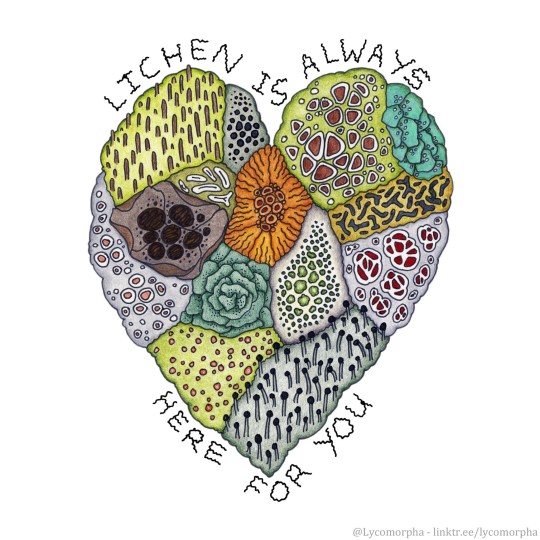
Smol reminder 💚🌿
I'm recovering from some medical treatment right now and I'm the worst patient at stopping and resting. So this is as much as note to self, to slow down and look at the lichens 😊
#lichen#lichens#lichenology#mycology#fungi#fungus#algae#symbiosis#drawing#colour pencil drawing#color pencil
748 notes
·
View notes
Text
Discovering Citizen Science
I have mentioned in previous blog posts that one of the best decisions I have made in the last 5 years was to get involved in my local mycological society. Foray NL is a not for profit collaborative group that involves folks from a variety of backgrounds including mycologists, lichenologists, indigenous partners, students and citizen scientists. All of these people get together once a year to collect, analyze, identify, photograph, and catalogue mushroom and lichen species from across Newfoundland. Each year new species are discovered, species that have never been collected before or in some cases never been identified before. There are so many different kinds of mushrooms and lichens. Lichen identification by Foray NL has helped to play a part in conservation efforts here in Newfoundland. It makes me feel like we are making a small but meaningful difference in the world. It is truly fascinating that despite the tens of thousands of specimens collected over the 20 years Foray NL has been active, we still have only grazed the surface of biological variety. This element of discovery really ignited a curiosity in me that has led to a new career path, and has helped me discover a joy in continued studies as an adult (such as this course!)
Citizen science is about asking questions and observing. Check out this mushroom house party! What kind of music do you think they are listening to?
In 2019 when I attended my first Foray NL three day event. I was initially a bit nervous, but interested in learning more about mushrooms as an amateur forager. It fascinated me to discover that there are edible food sources wherever we go. Knowing what to eat was just a matter of researching a bit more about plant and fungi biology. As a forager I wanted to know what else I could eat aside from the wild berries, Labrador tea, and plethora of edible backyard weeds. I wanted to dive head first into the woods and talk to the people that knew about wild food sources, and how not to die while eating mushrooms. What I didn’t expect was a welcoming, interesting community of people who were maybe a bit eccentric, but incredibly knowledgeable, funny, caring and ready to take on the world on mushroom at a time. I don’t remember what I was expecting, but when I stepped into the “mush-room” I was blown away. The “mush-room” is a large makeshift laboratory where all the species of mushrooms that have been collected over the weekend are laid out for identification on tables. There were piles of books for identification, a photography booth, microscopes, dehydrators and tables and tables of unique fungi and lichens. The variety was astounding to someone who really only knew about wild chanterelles. I went past each specimen taking in their names, features and examining their qualities. I observed their spores on microscope slides, witnessed bio-luminescence in the photo room, and along the way learned so much from each person I spoke with. It was fun, and I helped to contribute to the collection, my role even had a name - citizen scientist. This slow building of knowledge has been incredibly rewarding and the yearly event is something I continue to look forward to. My hope is that by sharing my story other folks will reach out to similar organizations and seek out the knowledge that lingers there. You too can be a citizen scientist!
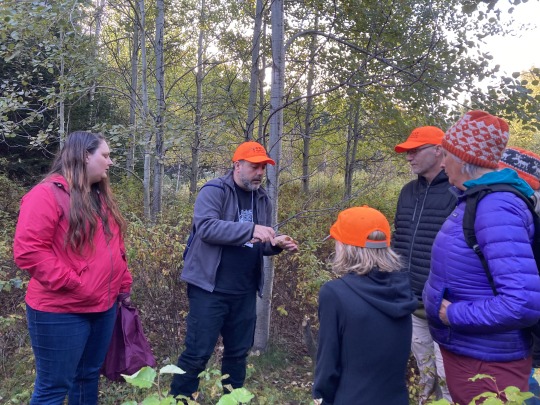
Folks at Foray NL learning about how to identify mushrooms.
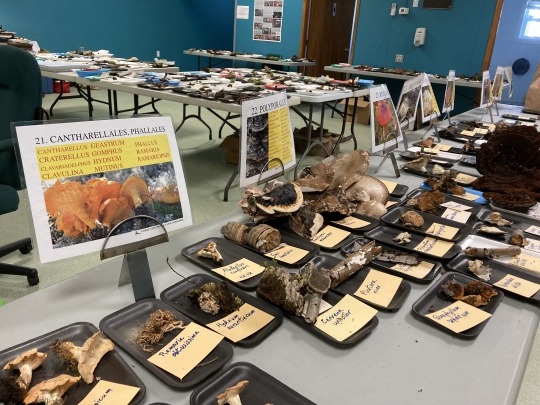
The "Mush-Room" identification tables at Foray NL

One specimen of identified mushrooms on the table.
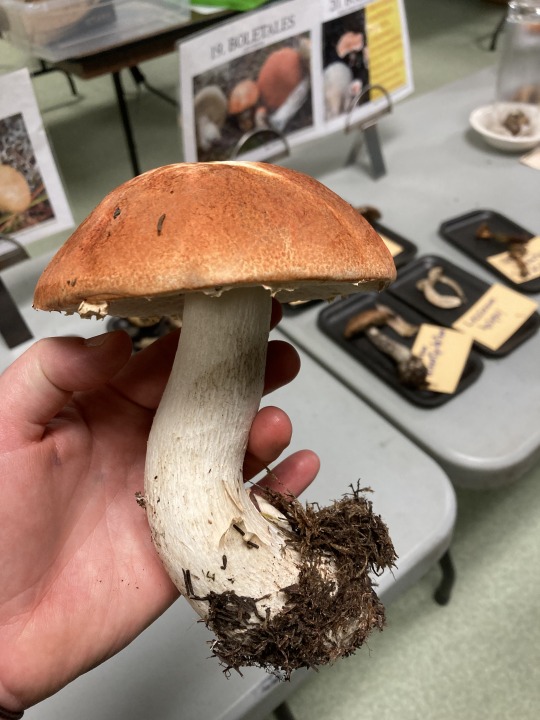
A bolete! From the tables, 2023.

Science! Is for everyone!
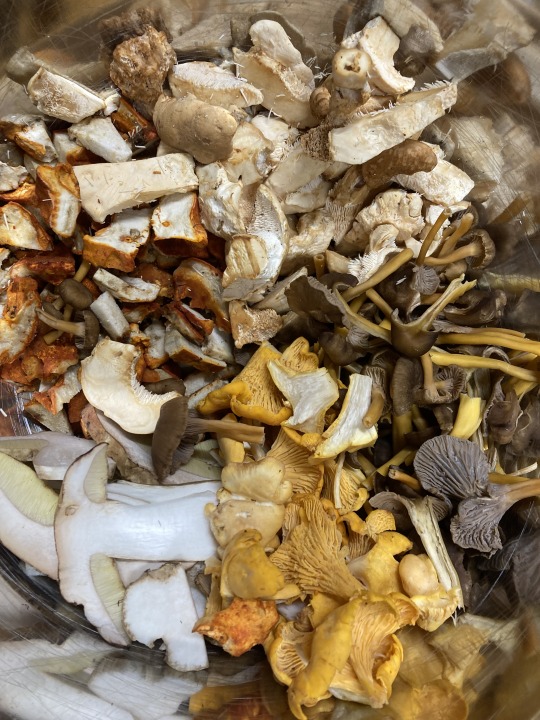
My favourite part, prepping and eating a foraged fungi feast for everyone at Foray NL to enjoy after a day in the woods collecting specimens.
8 notes
·
View notes
Text







Frosty saucer 》 Ochrolechia africana
One of the most beautiful lichens I've found recently. I love the texture the apothecia create when they cluster together like this. What I wouldn't give to be small enough to wander this structure like a field.
The one in the fourth image is possibly a different species.
Southeast Texas, 7 July 2024
#amatuer mycology#mushrooms#mycology#fungi#mushroom hunting#mushrooms of texas#texas mushrooms#wild fungi#fungi of texas#fungarium#lichen#lichenology#lichen species#lichen identification#crustose lichen#species identification#frosty saucer#apothecia#texture#special interest#goblincore#crowcore#trypophobia#tw trypophobia
136 notes
·
View notes
Text

Some thicc devil's matchstick lichen.
#artists on tumblr#original photographers#original photography#hiking#pacific northwest#nature#nikon#washington#pnw#orofeaiel#devil's matchstick#lichen#forest finds#small worlds#goblincore#lichenology#Cladoniaceae#macro photography
89 notes
·
View notes
Text
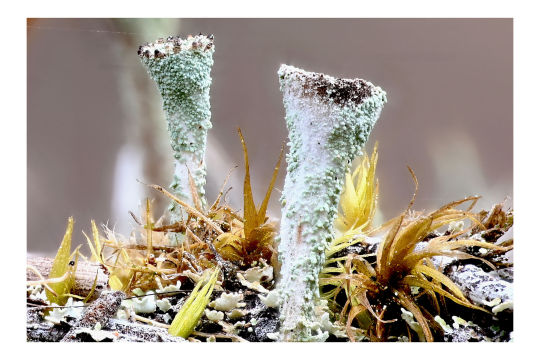
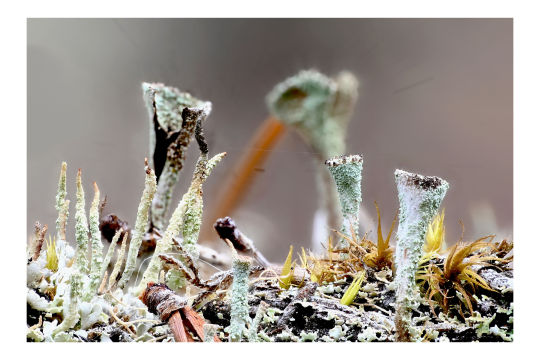

Cladonias, on bark of a decaying shore pine, 60 image stack
Samoa Dunes, California
#cladonia#lichen#lichenology#forest floor#nature#macrophotography#imagestack#nikon#original photographers
17 notes
·
View notes